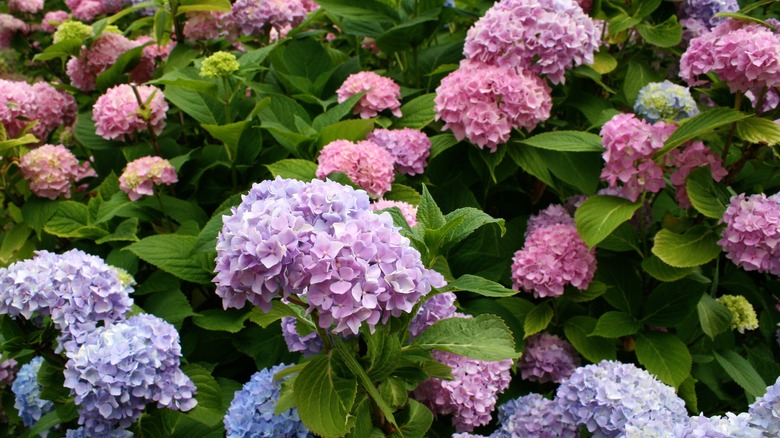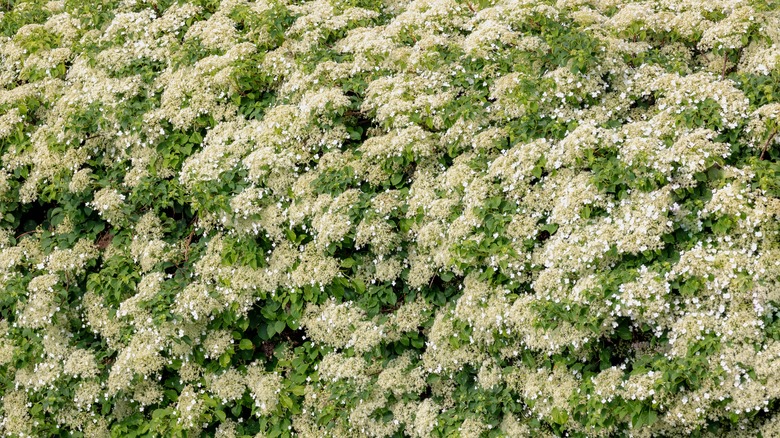3 Stunning Types Of Hydrangeas That Deer Won't Be Tempted To Eat
When you think of deer, it's easy to imagine the sweet and adorable animals depicted in movies and children's storybooks. The ones in your garden, however, are more likely to be a real-life horror. Deer are notorious for wreaking havoc in people's gardens, devouring nearly everything in their path. If you have hydrangeas, you may remember the feeling of finding your flowers damaged by these animals. There are countless tips and tricks that promise to help you keep deer out of your garden but, as long as you still have a good food source for them out in the open, there's bound to be a brave few that push beyond your tricks. There's no plant that is completely deer-resistant, but there are certainly some that deer don't favor. Bracted, bigleaf, and climbing hydrangeas aren't high on deer's menu so they're your best bet when looking for a plant that can withstand their browsing.
It's important to note though that even though some plant varieties might not be a deer's favorite meal, they might be forced to dig in when they're left with no other choice. Winter can come with reduced foliage or snow-capped trees, which leads to animals fighting for the little food that's available to them and leaving the others to settle for the less palatable kinds –- like your hydrangeas.
Bracted Hydrangeas
Largely considered the most deer resistant hydrangea variety, bracted hydrangeas are the perfect shrub to plant if you're looking for a full and dramatic landscape. The shrub grows into round, dense bushes that are perfect to plant as borders. Bracted hydrangeas are a popular choice for gardeners because of the elegant and stunning element their creamy white bracts bring to the outdoor space. These flowers are a great deer resistant choice because of how soft and fuzzy the leaves are. This is not a texture deer really appreciate. They might browse a few times at first but they won't be back if there are other choices they can enjoy instead.
Another great advantage about bracted hydrangeas is that they usually bloom much later in the season in comparison to other plants. That means that there are already other much more palatable options deer can eat. Bracted hydrangeas are usually a fairly low-maintenance plant. Plant them in an area where they could be able to enjoy the morning sun but take cover in afternoon shade later on. If you live in an area with warmer climates, plant your bracted hydrangeas in full shade to avoid browning and wilting from heat stress. Water them generously every week to ensure the soil can maintain adequate moisture.
Bigleaf Hydrangeas
If hydrangeas were a music band, the bigleaf hydrangea would be the lead singer. It is probably the most popular variety among hydrangeas –- after limelight hydrangeas, of course. This hydrangea variety isn't as popular for its deer resistance as it is for its looks. As its name suggests, bigleaf hydrangeas have large and broad leaves that surround round vibrant blooms. Their heart-shaped leaves grow to create dark and contrasting foliage that acts as a backdrop to the main event. Mature bigleaf hydrangeas have thicker and tougher leaves that are probably the reason deer aren't likely to circle back for them. Younger bigleaf hydrangeas aren't so lucky, unfortunately.
When planting your bigleaf hydrangeas, consider adding a few walls of defense to protect your young plants from deer and other unwanted visitors. Chicken wire or some secure netting could be a good starting point when considering ways to protect your tender plants. You could also choose to plant them in a container as they start out and transplant them out in the garden later on once their foliage is strong enough to repel and repulse those stubborn deer.
Climbing Hydrangeas
Climbing hydrangeas aren't deer resistant insomuch as they are simply out of reach. As you can imagine, climbing hydrangeas are a vining variety and tend to be planted against a supportive structure like a trellis, wall or other plants like trees. Their vines can grow up to 50 feet tall. They are what summer fairytales are made of, but these flowers offer visual appeal for every season of the year. Like bigleaf hydrangeas, consider planting younger climbing hydrangeas in containers and allowing them to grow against an artificial support structure before you can transplant your hydrangea in the garden later on.
Alternatively, you can plant them outside and add a layer of chicken wire or good fencing around the vining plant. Either way, make sure deer can't access the plant when it's still short or it might never be able to grow and reach its full potential. Even if mature climbing hydrangeas experience the occasional browsing or nibbling from deer, the damage is usually very minimal and not something the plant will struggle to come back from.



